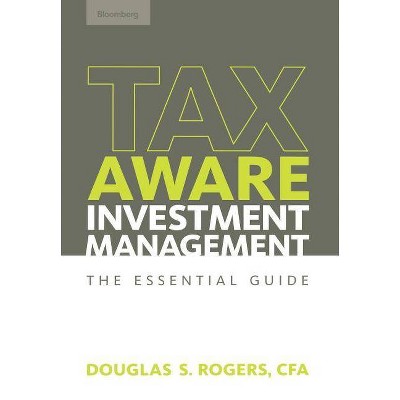Foundations of Investment Management - by David E Linton (Hardcover)

Similar Products
Products of same category from the store
AllProduct info
<p/><br></br><p><b> About the Book </b></p></br></br>"Foundations of Investment Management: Mastering Financial Markets, Asset Classes, and Investment Strategies shows how to navigate today's world of complex financial instruments, investment opportunities, and devastating pitfalls. This reader-friendly guide details stocks, bonds, and alternative investments, who invests in these asset classes, how, and why. It uses real-world examples in addition to citing the latest academic research. Additionally, seven industry experts have co-authored select chapters to greatly expand the depth and utility of this book for the reader. This unique guide is perfect for financial analysts, portfolio managers, client-facing representatives, product specialists, and anybody early in their finance career who wishes to understand how clients, products, and investors relate and interact"--<p/><br></br><p><b> Book Synopsis </b></p></br></br><i>Foundations of Investment Management: Mastering Financial Markets, Asset Classes, and Investment Strategies</i> shows how to navigate today's world of complex financial instruments, investment opportunities, and devastating pitfalls. This reader-friendly guide details stocks, bonds, and alternative investments, who invests in these asset classes, how, and why. It uses real-world examples in addition to citing the latest academic research. Additionally, seven industry experts have co-authored select chapters to greatly expand the depth and utility of this book for the reader. This unique guide is perfect for financial analysts, portfolio managers, client-facing representatives, product specialists, and anybody early in their finance career who wishes to understand how clients, products, and investors relate and interact. <p/><i>Foundations of Investment Managemen</i>t provides a complete overview of the investment management industry; defines key terms and participants; identifies investment vehicles, strategies, and asset classes; and analyzes each strategy focusing on its relative utility and potential inclusion in a well-diversified portfolio. Despite the subject mater's complexity, each topic is distilled in a way that is highly relatable and intuitive, ensuring the reader knows how to better manage their investments or interact with clients. Lastly, every chapter closes with a summary and investment implications to maximize the information presented. <p/> Key Features <p/> - Defines various fund structures, discusses the growth of the mutual fund industry, explains the benefits and disadvantages of comingled vehicles and details other investment options including fund of funds, annuities, and separately managed accounts <br> - Presents detailed descriptions of different institutional investors; elaborates on their investment considerations, objectives, and reaction functions; and concludes with implications for an institutions' propensity to respond similarly to market developments <br> - Supplies tools and techniques to construct and optimize a fixed income portfolio <br> - Reviews the history of the Bank of England and U.S. Federal Reserve and describes central bank objectives, tools, and reaction functions <br> - Illustrates the difference between investing and speculating by introducing different valuation methods and approaches to developing an investment thesis <br> - Examines the growth of high frequency trading and identifies rebalancing strategies <br> - Identifies different stock investment approaches as well as introduces several equity valuation methods <br> - Describes mean variance optimization and conviction-based portfolio construction approaches <br> - Reviews bond basics including bond income, interest rate sensitivity, and sources of risk such as credit and liquidity <br> - Examines the history of real assets, defines each real asset, details the drivers of their return, and explains how an investor may gain exposure to each asset through the utilization of financial instruments or investment vehicles <br> - Presents the theory behind and history of factors and factor investing from both an academic and practitioner perspective. <br> - Presents the development of our understanding of behavioral biases, explains how these biases impact investment decisions, and provides tips and techniques to avoid their pitfalls<p/><br></br><p><b> Review Quotes </b></p></br></br><br>"David Linton is the epitome of a scholar practitioner. He understands the theory, the real world, and how the two interact. <i>Foundations of Investment Management </i>is a comprehensive examination of the process of investing, covering the key investment instruments, the markets they trade in, and their role in portfolio construction." --Stephen G. Moyer, CFA, Adjunct Professor, University of Southern California, Author of <i>Distressed Debt Analysis</i><br><br>"Foundations provides not only an excellent introduction to the field of investment management, but it also, perhaps more importantly, provides context on how to make this information actionable in a way that few books do (or try). The more time you spend reading books like this one the better prepared you'll be for whatever the future holds." --David Blanchett, PhD, CFA, CFP, Head of Retirement Research at Morningstar Investment Management LLC<br><br>"This marvelous book is thorough, rigorous, and comprehensible--an unusual combination. It is an indispensable reference for both practitioners and those interested in the investment management arena. It deserves to be on the bookshelf of every serious investor. David Linton has beaten the market of investment books!" --William H. Miller III, Founder of Miller Value Partners and Former Chairman and CIO of Legg Mason Capital Management<br><p/><br></br><p><b> About the Author </b></p></br></br><b>David E. Linton</b>, CFA, is the Director of Portfolio Construction and Manager Research at Pacific Life Fund Advisors LLC (PLFA). In his current role, he is responsible for the portfolio construction of the $32 billion PLFA suite of asset allocation products, and he shares responsibility for the manager research and due diligence for roughly $40 billion in sub-advisory relationships. Additionally, David is a member of the PLFA Investment Committee and Asset Allocation group, specializing in fixed income, and he is the lead trader for the $1.2 billion Pacific Funds Multi-Asset Fund. <p/> Prior to joining PLFA, Mr. Linton was a Vice President and Portfolio Manager at PIMCO. While there, he worked in a variety of capacities and his responsibilities included co-managing PIMCO's overnight cash investing and financing book on the Short-Term Desk, working as a sovereign credit analyst on the Emerging Markets Desk, and trading investment grade non-financial corporate bonds on the Investment Grade Corporate Desk. David was also a Product Manager and member of the PIMCO Solutions group with a focus on Tail Risk Hedging. <p/> Mr. Linton is a CFA(R) charterholder, has a BS in Business Administration from the University of Southern California, graduating magna cum laude, and an MBA from the University of Chicago Booth School of Business, graduating with honors.
Price History
Cheapest price in the interval: 45.49 on November 8, 2021
Most expensive price in the interval: 45.49 on December 20, 2021
Price Archive shows prices from various stores, lets you see history and find the cheapest. There is no actual sale on the website. For all support, inquiry and suggestion messagescommunication@pricearchive.us




















